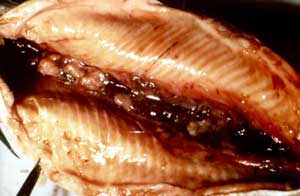Renibacterium salmoninarum
Work in Progress
Characteristics of the symbiont/pathogen
Renibacterium salmoninarum is a gram-positive bacterium that was first described in 1930 when it was found in Atlantic Salmon in Scotland. It is also known as Renibacterium salmonina and Corynebacterium salmoninus. This bacterium causes Bacterial Kidney Disease (BKD), also known as corynebacterial kidney disease and salmonid kidney disease in salmonids. The bacterium is characterized by its small, diplobacillus, and rod shape. It does not form spores, nor is it motile or encapsulated. When grown on agar, this bacterium can be characterized by it opaque, smooth, convex, and shiny colonies which are a creamy yellow in color. Colonies may vary in size. If atypical, dormant cells from this bacterium may be rod or coccoid in shape. Typically, the cells are 0.8-2 μm long and >0.45 μm wide. Width can be used to differentiate between normal and atypical cells. The R. salmoninarum genome was published in 2008 and has 3,155,250 base pairs.
Phylogenetic Classification:
Domain: Bacteria
Kingdom: Actinobacteria
Phylum:Actinobacteria
Class: Actinobacteridae
Order: Actinomycetales
Sub-Order:Micrococcineae
Family: Micrococcaceae
Genus: Renibacterium
Species: R. salmoninarum
Characteristics of the host
What host/s is/are involved? Is there host specificity? Are there secondary reservoirs?

Renibacterium salmoninarum is the causative agent of Bacterial Kidney disease in salmonids. It primarily affects juvenile and pre-spawning salmonids.
Host-Symbiont Interaction
The interaction between the young salmonids and Renibacterium salmoninarum is an obligate parasitism. Bacterial Kidney Disease has led to dramatic declines of salmonids in fisheries. In Chinook salmon, BKD can demonstrate a number of the following symptoms: abdominal fluid build-up and swelling, pseudomembranes on viscera, kidney and gill necrosis, hemorrhaging on viscera and in intestines, ulcers or abscesses in muscles, protruding eyeballs, anemia, blood blisters, and lesions of the eyes, liver, spleen, and heart. Transmission of BKD can occur vertically or horizontally from other infected salmonids. R. salmoninarum can not exist outside its host for extended periods of time, however, it is thought that the bacterium can exist in the kidneys or digestive tract of a salmonid for long periods of time. BKD is not always exhibited in host salmonids and can be triggered by trauma to the host, acquisition of another infection, or damage to the kidneys or digestive tract.
Molecular Insights into the Symbiosis
Describe molecular/genetic studies on the symbiosis.
Ecological and Evolutionary Aspects
What is the evolutionary history of the interaction? Do particular environmental factors play a role in regulating the symbiosis?
Optimal growth of R. salmoninarum occurs at 10–20ºC. Growth does not occur at 30–37ºC. The bacterium is a neutrophile with its optimal pH ranging from 5.8-7.8.
Recent Discoveries
Describe two findings on the symbiosis published within the last two years.
References
[Sample reference] [[1] Seemanapalli SV, Xu Q, McShan K, Liang FT. 2010. Outer surface protein C is a dissemination-facilitating factor of Borrelia burgdorferi during mammalian infection. PLoS One 5:e15830.]
"DIAGNOSTICS, PREVENTION AND THERAPY OF FISH DISEASES AND INTOXICATIONS." FAO: FAO Home. Web. 11 Nov. 2011. <http://www.fao.org/docrep/field/003/AC160E/AC160E02.htm>.
"DNR - Bacterial Kidney Disease (BKD)." SOM - State of Michigan. Web. 11 Nov. 2011. <http://www.mi.gov/dnr/0,4570,7-153-10364_52259_10950-27345--,00.html>.
Faisal, Mohamed, Thomas P. Loch, Travis O. Brenden, Alaa E. Eissa, Mark P. Ebener, Gregory M. Wright, and Michael L. Jones. "Assessment of Renibacterium Salmoninarum Infections in Four Lake Whitefish (Coregonus Clupeaformis) Stocks from Northern Lakes Huron and Michigan." Journal of Great Lakes Research 36 (2010): 29-37.
Metzger, D.C., D.G. Elliott, A. Wargo, L.K. Park, and M.K. Purcell. "Pathological and Immunological Responses Associated with Differential Survival of Chinook Salmon following Renibacterium Salmoninarum Challenge." Diseases of Aquatic Organisms 90.1 (2010): 31-41. Sanders, J. E., and J. L. Fryer. "Renibacterium Salmoninarum Gen. Nov., Sp. Nov., the Causative Agent of Bacterial Kidney Disease in Salmonid Fishes ." International Journal Of Systematic And Evolutionary Microbiology 30.2 (1980): 496-502.
Sandell, T. A., and K. C. Jacobson. "Comparison and Evaluation of Renibacterium Salmoninarum Quantitative PCR Diagnostic Assays Using Field Samples of Chinook and Coho Salmon." Diseases of Aquatic Organisms 93.2 (2011): 129-39.
Wiens, G. D., D. D. Rockey, Z. Wu, J. Chang, R. Levy, S. Crane, D. S. Chen, G. R. Capri, J. R. Burnett, P. S. Sudheesh, M. J. Schipma, H. Burd, A. Bhattacharyya, L. D. Rhodes, R. Kaul, and M. S. Strom. "Genome Sequence of the Fish Pathogen Renibacterium Salmoninarum Suggests Reductive Evolution Away from an Environmental Arthrobacter Ancestor." Journal of Bacteriology 190.21 (2008): 6970-982.
Edited by Shannon L. Carey, student of Grace Lim-Fong
This template is just a general guideline of how to design your site. You are not restricted to this format, so feel free to make changes to the headings and subheadings and to add or remove sections as appropriate.
